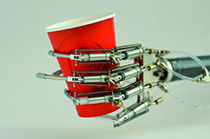
Photograph of the Delft Cylinder Hand with the cosmetic cover. Photographs courtesy of Gerwin Smit and TU Delft.
Researcher Gerwin Smit, PhD, has developed what he says is the lightest ever prosthetic hand. The work was presented as part of his dissertation, “Natural Grasping: Design and Evaluation of a Voluntary Closing Adaptive Hand Prosthesis,” for which he was awarded his doctorate on June 11 from Delft University of Technology (TU Delft), Netherlands.
Smit said that having examined some of the underlying reasons why individuals with hand amputations do not wear a prosthesis-lower user comfort (too heavy, too hot), too few functional advantages, and a lack of sensory feedback-he decided to address these issues. He compared current prosthetic hands and came up with an alternative: a body-powered prosthetic hand with hinged fingers, hydraulically operated with miniature cylinders that are so small they fit inside a finger. The hand is operated through subtle movements of the shoulder and the upper arm by means of a shoulder harness, which the user can quickly learn.

The hydraulic cylinder mechanism is visible in this photograph of the Delft Cylinder Hand.
“It’s all about the three Cs: cosmetics, comfort, and control,” Smit said. “The prosthesis needs to be attractive to look at, comfortable to wear, and easy to operate. My objective was to design and test a lightweight and mechanically efficient body-powered prosthetic hand with hinged fingers. A low amount of mass improves comfort, while mechanical efficiency will reduce the operating force required and increase operating comfort. As a result, the hand will also be able to grip more firmly. The hinged fingers enable both the pincer grip and the cylinder grip to be formed, so that a broad range of various objects can be held.”
Dubbed the Delft Cylinder Hand, he says it weighs less than 217 grams, making it more than 50 percent lighter than the lightest myoelectric prosthesis; the grip strength is greater than 30 newton; it requires the user to exert less energy to operate than is needed with the current range of body-powered hands; and its cost is comparable to that of a myoelectric prosthesis. It is also dexterous enough to allow the user to write and use a pair of tweezers.
The Delft Cylinder Hand has been extensively tested at TU Delft with test subjects and prosthesis users. It is now ready to be tested beyond TU Delft in clinical trials. “I expect that this prosthesis could be ready for use within five years,” Smit said.
Editor’s note: This story has been adapted from materials provided by TU Delft, which also offers a video of the hand in action on its website.




